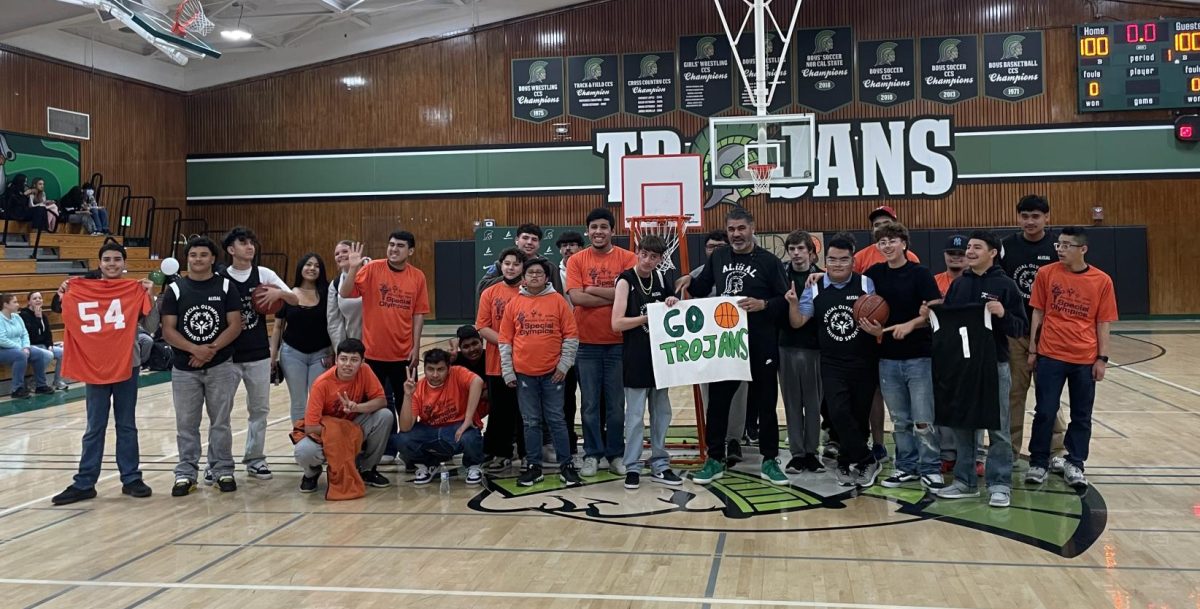When we think of cafeteria food, every student has their favorite free lunch menu item. Whether it’s a spicy chicken sandwich or a kale salad, the cafeteria welcomes hungry students piling up in line as soon as 4th period is over, eager to pick up their free lunch. For students who are vegetarian and vegan, the story is much different. Besides generic salads that come in small portions, and monotonous yogurt parfaits, the cafeteria simply does not provide enough food options that suit the dietary preferences and needs of those students who follow a plant based diet.
This upcoming May will mark 3 years since I made the switch to vegetarianism, and I’ve never had so much trouble finding something to eat than I do at our very own school cafeteria. On most days, I usually stop by the cafeteria to pick up my daily lunch; a mozzarella string cheese and some variation of fruit. On some days, if I get to the cafeteria quick enough, I’ll grab a yogurt parfait (that is, if it’s on the menu at all that day). It goes without saying that this is not a suitable lunch for a growing teenager, especially not for those who are in sports such as myself, but the food options at the cafeteria are limited and leave us with no other choice. In addition to lunch time, students can find the cafeteria open after school for those who are looking for a quick snack before putting in some extra studying time at tutorials, or for athletes who want to grab something light to eat before practice. As a runner myself, I find it to be a crucial step in my after school routine to stop by and grab something small to fuel up with before my 4+ mile long runs at practice, and I find that there’s more vegetarian options in the snacks served after school than in the meals served during lunch such as Pop Tarts, Uncrustables, Trix Yogurt, and cereal bars, all of which regardless have low nutritional value and are once again, not suitable for vegans.
While the cafeteria menu has welcomed two new salads to the menu, both are still not vegan nor are they vegetarian. The newly introduced kale and southwest salads have become fan favorites among many students for their large portions and many toppings; unfortunately, one of the toppings being chicken that already comes embedded within the salad. A more plant based option suitable would be the other, second rate salad that has been a menu item for as long as anyone can remember. This salad comes in a significantly smaller portion, but is more inclusive of vegetables namely carrots, cucumbers, and cherry tomatoes, along with other additives such as croutons and ranch dressing. Though this is a food option that is healthy, plant based, and served everyday during lunch, I know many such as myself have grown tired of eating the same thing every single day purely because of the fact that it’s one of the only options available. Yogurt parfaits are small but loved by many, and while they are delicious they’re not suitable for vegans because of the dairy in the yogurt. The only food that vegans can really find when stopping by to pick up their free lunch besides the salad are the fruits and vegetables, which really puts in perspective the scarcity of meals available for them.
According to the California Department of Education, “On June 30, 2022, Governor Gavin Newsom signed AB 181 (Statutes of 2022) into law. This law appropriated $100 million from the State of California’s General Fund to the California Department of Education” in order to support the addition of California grown or produced, sustainably grown, and whole or minimally processed foods for plant based or restricted diet meals in cafeterias for students. Furthermore, this fund also provides procuring plant based or restricted diet meals, and freshly preparing meals on site. Despite this, many schools in California are not providing enough efforts to add more plant based foods to their menu. In an article by Spectrum News, “the US government heavily regulated all their recipes to meet specific nutrition requirements when it comes to the food served at school cafeterias,” but according to research included in the same article, it’s been proven that “healthy, protein-rich plant-based foods” such as lentils and beans are 26 to 34 times less carbon-intensive than the beef that’s currently being served in many school cafeteria lunches across the nation. In addition, the ACR 16 was a bill passed in 2003 which urged food authorities to develop school lunch menus that included more plant based vegetarian entrees, which the California Department of Education has said to be committed to working towards the goals listed in that very same bill, but why are they still working towards these goals and producing no real progress when it was passed about 20 years ago?
In recent years, it’s become increasingly popular for students to order food during lunch utilizing apps such as DoorDash, Grubhub, etc. On occasions where bland cafeteria food doesn’t sound the most appetizing or you’re having a craving for fast food, an easy and quick fix would be to have food delivered to you just in time for lunch, right? Not quite. While there’s many food places in our area that offer plant based food options, it’s not entirely practical or sustainable to spend money on food every single day, leaving students without the option to simply order food during lunch if there’s nothing for them in the cafeteria.
With all this being said, this leaves the question of what are some suitable meals for students who follow a plant based diet? Starting off with salads, it would be a quick and efficient fix to separate all toppings and make them a build your own type of salad where everything is separated from the greens and people have the option to disregard the meat. An even more elaborate but not peculiar idea would be to reintroduce the salad bar that our school once had but unfortunately has since gotten rid of. Chicken sandwiches can be imitated with veggie burgers that consist of patties made up of black beans or soy, which provide a source of rich protein. Yogurt parfaits can be accompanied by acai bowls which are made up of healthy fruits and don’t include any dairy. Options for milk can go beyond just cow milk to other plant based milks such as soy, oat, and almond milk, which not only are suitable for vegans but those who are lactose intolerant as well.
While there’s a paucity of food items that are vegetarian and vegan friendly in our cafeteria now, action to resolve this issue is already being taken. When asked SUHSD food services manager Veronica Muñoz why there’s such a dearth of plant based food items on our cafeteria menu, she explained that students simply “don’t have the knowledge that [it’s] something that can be offered,” along with other reasons that include not having a lot of vendors available that offer these types of food products and are in the district’s bid.
Muñoz also added, “If we say it’s plant based the students will be hesitant to taste it because they may relate it to tofu,” which has a unique texture and might be unappealing to many students. Matthew Lemons, a chef for the SUHSD district, added that oftentimes “districts have had trouble with saying vegetarian or vegan or anything plant based” because it can actually turn students who don’t follow a plant based diet off from selecting those certain types of foods.
Lemons is part of the Brigaid program, a startup company that began challenging the school food status quo by putting professional chefs into public schools to cook fresh and wholesome food. Recently, a district conference meeting was held to discuss the different plant based food items with the possibility of being added to our school menu including vegetarian fried rice with veggie dumplings, fresh wraps, vegetarian pastas, replacement items for chicken tenders and patties, as well as working with a small company that is particularly new in the school food scene, but it has retailed at stores such as Whole Foods, with Lemons describing their products as innovative, as they use “a product called koji [which is] basically a protein replacement similar to tofu” that helps them imitate foods such as “pastrami, bacon, and ham.”
Lemons said students can expect to see changes to the menu as early as this school year, “with the menu changes that have kind of already started taking place we’re just in the beginning stages of rolling out new menu items and changing and adapting the menu so you’re gonna start seeing a lot more stuff coming on,” he said.
The process of altering the school menu and adding new items is more complicated than one might think, “A lot of people don’t understand how difficult it is to come up with a menu item and include it in the weekly menu because we have to include a lot of guidelines that we follow through the state,” Muñoz said.
Unfortunately, a huge barrier preventing schools in our district from releasing plant based food items is simply the fact that they don’t know how many students would be interested in having these types of foods in their cafeteria in the first place. “We don’t want to go forward and put all the work into putting plant based items out and have them getting thrown out,” Lemons said.
Nonetheless, there’s eminent hope for change in our school cafeteria regarding the inclusivity of vegetarian and vegan friendly food options, “as soon as we can get the information to see like, you know, 10% of students would like to see this then we can start rolling them out and they would definitely be this school year,” Lemons said, adding that, “in the next few months we have close to 20 items that are going to be coming out, so you’re going to start seeing new things, you’re going to start seeing new proteins, you’re going to start seeing all this stuff.”
Schools all across the country have a long way to go before they implement sufficient food options suitable for vegetarians and vegans, but taking these simple steps can guarantee that students will not only have the selection to opt for healthier foods every time they pick up their free lunch, but will have the resources necessary to them in order to fulfill their dietary preferences in case they live a plant based lifestyle.






![Senior Jayden Duarte dives across the goal line for one of his five touchdowns in a dominant 62-40 victory over Monterey. It has been a highly successful season for Duarte, and he credits his coaches for putting him in positions to succeed and make key plays. “The goal is to help wherever the coaches need me, receiver, running back, [and] DB,” he said.](https://alisaltrojantribune.com/wp-content/uploads/2025/10/IMG_3599-2-1200x800.jpg)

















